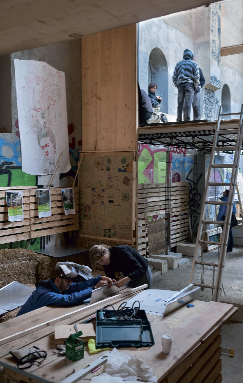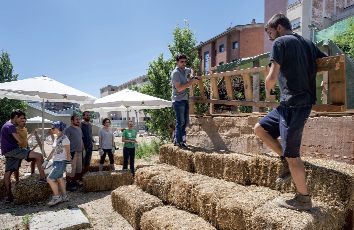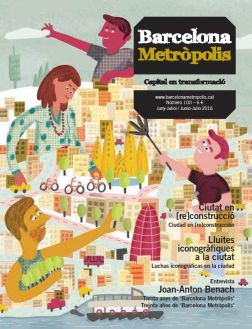The vitality of a city like Barcelona can be better measured by the amount of conflict that it is capable of containing and managing, rather than by the hegemony of a homogenising logic of consensus. Opting for a city of citizens means avoiding borders, segmentation and the commercial appropriation of what belongs to everyone.

Photo: Dani Codina.
In this plot on Passeig de Valldaura in Nou Barris, the proposals that won the 2015 Pla Buits (empty spaces plan) contest will be implemented. This plan entails the City Council granting use of municipal plots to non-profits for the development of training and leisure projects aimed at rebuilding the urban fabric. On this site, an urban allotment and a rainwater bioretention area will be installed.
Barcelona has seen growing tension in public spaces where ever more diverse people, uses and habits congregate. These public spaces have been improving in terms of quality, but they receive more use, sustain more relationships and are more heterogeneous and multifunctional throughout the year and at different hours of the day than they were in the 1980s. We should note that Barcelona – together with Hospitalet, Santa Coloma, Cornellà and Badalona – is the most densely populated metropolitan area in Spain and one of the most densely populated in Europe. We should not be surprised, then, that common areas in the city may be considered (implicitly or explicitly) as places of ongoing negotiation between a broad range of people, groups, purposes and uses.
We can say, then, that the city and its spaces are difficult to operate and to “govern”. This is not a problem specific to Barcelona, but there are few cities where this complex situation manifests itself so intensely. The combination of the city’s size (small), its density (high) and the number of people who visit it (growing exponentially) makes this issue one of particular concern for public institutions, entities and residents’ groups.
Cities, as we know, strongly reflect economic, political and social changes. They are large deposits that bring together a high concentration of human relationships and the tensions generated by this intense and constant coexistence. In this regard, cities gather and amplify the sudden and profound changes that have shaken the world over the last twenty years and that inspire talk of a “new era” on the horizon. Barcelona has not been exempt from these changes, rather it is one of the clearest examples of them.
The new social scenarios present themselves, on one hand, as driving forces for new opportunities that may facilitate a break with the stable rigidity of social partitions that are characteristic of industrial societies. However, they may also generate new forms of inequality and imbalance that impact social sectors traditionally subject to these processes as well as new sectors and individuals who were generally not involved or who previously had family ties and social networks that functioned as counterweights to such phenomena. Employment is increasingly intermittent and precarious, and people harbour many uncertainties about the future.

Photo: Dani Codina.
BioBui(L)t, on Carrer de Montalegre, one of the winning projects of the first Pla Buits competition, is a place of work, training, dissemination and exchange about practices for the self-management of public space.
Barcelona’s social structure has diversified enormously both due to the arrival of many people from other areas in the space of just few years and because of changes to age demography which have been marked by a growth in the number of people over the age of sixty-five. At the same time, family structures have become more pluralistic, and the once traditional father-mother-children family structure has been on the wane for some time. The economic crisis has worsened the living conditions of many people. It has also brought more poverty and fragility in regards to the affordability of housing, energy and basic services.
All of these signs of change are the scenario in which the relationship between the city and its citizens is framed in cities such as Barcelona, with everything that such factors entail in regards to the diversity and complexity of uses and occupation of public spaces. More people, a greater diversity of people, locals and outsiders, different mixtures and intensities of economic, social and cultural uses that do not always coexist amicably, uses that generate conflicts and introduce external factors and that today cannot be easily resolved by applying only hierarchical and authoritarian logic.
The attractiveness of cities
As Richard Sennett says, despite the great disadvantages often associated with living in cities, their urban appeal is still evident: “cities have the ability to make us feel much more complex as human beings”. Conflict calls for innovation; diversity is stimulating and allows you to be yourself without necessarily needing to be like the rest. But for this all to be possible, it is necessary to have an idea of citizenship that allows for a combination of personal autonomy (so that everyone can be what they want to be), equality (so that everyone is considered the same, although they are different) and diversity (so that everyone is recognised for what they are and is afforded the same level of dignity as others). Rubert de Ventós has expressed it thus: “The city […] is characterised by a delicate balance between conception and anonymity, between speciality and identity, between space and time, between form and memory, between recognition and distance.”
Public spaces in a city like ours are ideal places in which to test the capacity to respect this idea of citizenship, of city, referred to earlier. Public space is first and foremost a physical space. That is, a place that can overcome short supplies of housing, light and air. We have proven this in Barcelona, where the districts with the worst housing conditions tend to be the most densely populated ones and the ones which make the most use of the few available public spaces. Public spaces are also spaces for social interaction and political and cultural activity. We see this now in Barcelona, whose squares and streets have become in recent years the perfect place in which to air complaints, express contradictions and suggest alternatives. But they are also areas of economic activity – whether permanent or temporary (markets, restaurants, bars, etc.) – and here again Barcelona has suffered the effects associated with the use of public spaces for private and commercial purposes.
Ensuring the quality and sustainability of space
Comparing these different public spaces with natural resources, we can concur with Elinor Ostrom, who in her book Governing the Commons: The Evolution of Institutions for Collective Action suggested ways of managing and governing these spaces that will enable us to preserve their qualities and ensure their sustainability. This requires us to involve the full range of stakeholders in the management of these areas. We have neighbours who must co-exist there. We have people who work in them and others who “exploit them”. We have users of these areas, in some cases users of the services that have been established in them, and in other cases users of the physical space (who may or may not be residents). The flows of occupation of these spaces are variable throughout any given day and throughout the year.
Depending on the dimensions of spaces and the density of uses and occupants, a rivalry of uses may occur and degenerate into potentially serious shortfalls in space resources. When it comes to the uses and availability of the city’s spaces, at the end of the day there are always winners and losers. And in Barcelona, these tensions are more frequent in the districts and in spaces where densities and rivalries are more intense.

Photo: Dani Codina.
A bio-construction workshop for Gardenyes de Sarrià, a community area that has been built around urban gardens, bio-construction workshops and activities organised by district associations. The space is included within the Pla Buits initiative and is managed by the l’Associació Cultural Casa Orlandai.
So then, how can we govern or manage these spaces in a way that will facilitate open and varied use? I would also ask, how can we do so while ensuring the preservation of our often-expressed ideals of citizenship? We must ensure the existence of what might be called vital space. That is, areas in the city that can be used in a general way and without commoditisation and use restrictions (parks, riverbanks, beaches, etc.). Moreover, every city must have, when needed, political and social spaces – spaces that embody the right every citizen has to the city (squares, streets). And of course, there will also be public spaces where commercial and mercantile profiteering is allowed (markets, terraces, vendors), with the conditions and restrictions needed to avoid conflicts and to avoid rejecting the above-stated principles.
Individual autonomy, equality and diversity
Obviously, and within the perspective I am defending, it will be necessary to work on enhancing diversity and prevent limitations from being placed on access to the city’s public spaces. Taking the idea a step further, we could say that one of the clearest elements in recent times is the inclusion of the concept of diversity within the classic tension between freedom and equality. Given that progress has been made, we could say that citizenship stems from a triangle of tension between individual autonomy, equality and diversity.
The solution to the issue of space should strike a balance between these three perspectives: maximum personal autonomy and, thus, the capacity to contain heterogeneous and personalised uses; minimal restrictions on access and, therefore, the non-discriminatory use of space with consideration for the redistributive functions that these spaces promote; and the capacity to assimilate the different conceptions of space that are inherent to different perspectives (gender, place of origin, culture, life choices, etc.). This is not a stable equilibrium, and we should not assume that this interrelationship will work without tension.
” The relationship between space and citizens has produced new ways to sustain these unstable and negotiated equilibria on a moment to moment basis. “
A serious consideration of all that has been said here may lead us to say that the vitality of a city like Barcelona can be better measured by the amount of conflict that it is capable of containing and managing, rather than by the hegemony of a homogenising logic of consensus. Over the past thirty years, Barcelona has reflected the will to rebuild the urban sphere, to reconstruct spaces for everyone’s benefit, to provide quality public spaces when private spaces lacked quality, to avoid urban and social segmentation and to continue welcoming visitors and new citizens. Thus, in the city the relationship between space and citizens has produced new ways to sustain these unstable and negotiated equilibria on a moment to moment basis.
In recent years, tensions have grown in line with internal inequality, also mirroring the increase in the commercialisation of space as well as the rise in the number of visitors to levels that cast doubts on the often fragile balances that have been achieved. The same things are not happening everywhere in the city, nor do these problems have the same magnitude everywhere. But if we are still interested in having a city of citizens (as we have defined it), where everyone has a right to the city, we must take care and act to ensure that cultural borders, demographic segmentation and commercial appropriation do not gain control of what we want to belong to everyone. There are signs that social organisations and movements as well as institutions are aware of the problems. And it is in all of our interests that they are.



